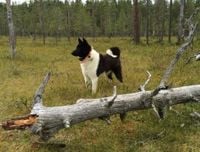The sight of a tiny Pomeranian bounding down the street or a massive Irish Wolfhound lounging in a park might make one wonder how such a staggering range of canine shapes and sizes came to be. For years, the prevailing belief was that this diversity was a product of modern selective breeding, particularly the work of Victorian-era kennel clubs. But a groundbreaking new study, published on November 14, 2025, in the journal Science, is rewriting the timeline of dog evolution—and it’s a story that stretches back much further than anyone previously imagined.
According to Science and corroborated by BBC News, an international team of researchers set out to trace the roots of canine diversity by examining the skulls of both ancient and modern dogs and their wolf ancestors. Over the course of a decade, they painstakingly collected and digitally scanned more than 600 skulls, some dating back as far as 50,000 years. Their findings? The emergence of physical diversity among domesticated dogs began at least 11,000 years ago, around the end of the last Ice Age—long before the formalization of breeds in the 18th and 19th centuries.
“Traditionally, major morphological diversification—especially extreme size and shape differences—was thought to have occurred only in the past few centuries, following the emergence of formal dog breeds in the 18th to 19th centuries,” said bioarchaeologist Allowen Evin of the University of Montpellier and the French research agency CNRS, co-lead author of the study, as reported by Science. “Our study shows instead that substantial cranial diversification was already well established during prehistory.”
The research team relied on a cutting-edge technique known as geometric morphometrics, which allowed them to map and measure the three-dimensional shapes of canine skulls with remarkable precision. This approach revealed that recognizably domestic dog morphologies—shorter and wider skulls compared to wolves—were already present about 11,000 years ago. Three such skulls were unearthed at an archaeological site in Veretye, in what is now northwestern Russia. “During domestication, dog skulls became proportionally shorter and wider compared with those of wolves,” explained Carly Ameen, a bioarchaeologist at the University of Exeter and co-lead author, to BBC News.
Before this evolutionary shift, Ice Age canids still bore a strong resemblance to wolves, both in appearance and likely in behavior. But as the climate warmed and humans transitioned from hunter-gatherer societies to more settled groups in the early Holocene, the evolutionary pressures on dogs began to change. “By about 10,000 years ago, half of the amount of diversity present in modern dogs is already present in the Neolithic,” Ameen told NPR. “So very early on in our relationship with dogs, we not only change them from wolves, but they begin to change amongst themselves and generate a lot of diversity.”
The study’s findings challenge the long-held assumption that the vast variety of dog breeds is a recent phenomenon, driven primarily by the aesthetic and status-driven preferences of recent centuries. “It’s really surprising,” Ameen remarked to BBC News. “And it starts to challenge the idea of whether it was the Victorians—and their kennel clubs—who were the driving force behind this.” Instead, the evidence suggests that ancient humans were already selecting for different canine traits thousands of years ago, whether for hunting, herding, guarding, or sledging. These early choices, shaped by practical needs and local environments, set the stage for the remarkable diversity seen in dogs today.
But what drove this early explosion of canine variety? The answer, it seems, is as complex as the relationship between humans and dogs themselves. Ameen and Evin, writing in The Conversation, emphasized that the early diversity was likely the result of a combination of factors: close interaction with humans, adaptation to different environments, and changes in diet. “It’s likely to be a combination of interaction with humans, adapting to different environments, adapting to different types food—all contributing to the kind of explosion of variation that we see,” said Ameen. “It’s hard to untangle which of those might be the most important one.”
One thing is clear: dogs have been much more than mere tools or status symbols for humans. As Evin put it, dogs have been “multifunctional partners” for millennia. “Beyond their utilitarian roles, dogs have held deep symbolic and social significance as companions, mediators and markers of identity. The archaeological record reflects both practical and symbolic entanglement, showing dogs fully integrated into human societies for millennia,” Evin told Science.
The researchers also highlighted the importance of further study, particularly of specimens from 25,000 to 11,000 years ago in central and southwest Asia. Such research could shed more light on the precise timeline and geographic origins of dog domestication—a topic that remains hotly debated among scientists. But there is little doubt about the impact dogs have had on human societies. “Ultimately, dogs are a mirror of human history,” wrote Ameen and Evin. “Their story is intertwined with ours, shaped by shared migrations, changing environments and evolving societies. As the first domesticated species—and still our most enduring companion—dogs offer a unique window into how humans have shaped the natural world and how the natural world has shaped us in return.”
Interestingly, the concept of a “breed” is itself a modern invention. “The concept of ‘breed’ is very recent and does not apply to the archaeological record. Because we only analysed skull morphology—and lack information on coat colour, body size or behaviour—we cannot identify specific breeds. However, we did not observe extreme cranial morphologies such as those of bulldogs, pugs or bull terriers,” Ameen clarified in Science. This means that while ancient dogs already displayed significant physical diversity, the exaggerated features of some modern breeds are indeed a product of more recent selective breeding.
As humans spread into new territories after the Ice Age, they brought their canine companions with them, inadvertently shaping their evolution through new environments, tasks, and diets. The result is the dazzling array of shapes and sizes we see in dogs today—a legacy not just of Victorian breeders, but of thousands of years of shared history between people and their four-legged friends.
The story of dog diversity is, in many ways, the story of humanity itself: a tale of adaptation, companionship, and the enduring bond between species. And as new discoveries continue to emerge from the bones of the past, our understanding of that bond only grows deeper.





